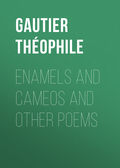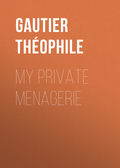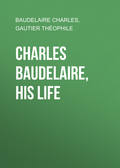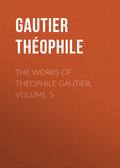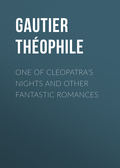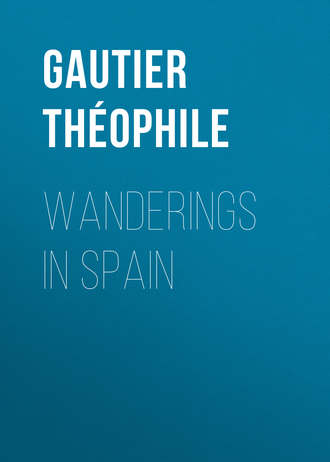
Gautier Théophile
Wanderings in Spain
CHAPTER I
FROM PARIS TO BORDEAUX
Departure from Paris – Subterranean Dwellings – Château-Regnault – Tours – Châtellerault – Angoulême – The Landes– Cubzac – Bordeaux – The Theatre – The Cathedral – St. Michael's Tower – Mummified Corpses – the Museum.
A few weeks ago (April, 1840), I happened, in an off-hand manner, to give utterance to the following phrase: – "I should like to go to Spain." Five or six days afterwards, my friends had suppressed the prudent "I should like," with which I had qualified my wish, and had told every one who chose to listen that I was about to undertake a trip to Spain. This positive formula was soon followed by the interrogation, "When do you set out?" while I, without thinking of the obligation under which I was placing myself, replied, "In a week." At the end of the week people began to manifest some astonishment at seeing me still in Paris. "I thought you were at Madrid," said one. "What! come back?" asked another. I saw at once that I owed my friends an absence of several months, and that I must pay the debt with the least possible delay, unless I wished to be mercilessly pursued, without a moment's respite, by my obliging creditors. The lobbies of the theatres, the various asphaltic and bituminous pavements of the Boulevards, were to me forbidden luxuries for the time being. All I could obtain was the grace of three or four days, and on the 5th of May I commenced relieving my native land of my importunate presence, by scrambling into the Bordeaux diligence.
I shall pass very rapidly over the first few posts, which possess nothing worthy of observation. Right and left stretch all kinds of crops, streaked like tiger or zebra skins, and bearing a most satisfactory resemblance to a tailor's book, in which are pasted his various specimens of trowsers and waistcoat patterns. Although these kinds of views are productive of great delight to farmers, landlords, and other worthies of a similar stamp, they afford but meagre entertainment to the enthusiastic and graphic traveller, who, spy-glass in hand, sets out to note the peculiarities of the universe in the same manner as a police agent does those of an individual. Having left Paris in the evening, my first impressions, after passing Versailles, are but so many feeble sketches stumped in by the hand of Night. I regret that I passed through Chartres without being able to see its cathedral.
Between Vendôme and Château-Regnault, which is pronounced Chtrnô in the language of the postilions, so well imitated by Henri Monnier in his sketch of the "Diligence," there rise a number of well-wooded hills, where the inhabitants dig their houses out of the living rock, and live under ground, after the fashion of the ancient Troglodytes. The stone obtained from these excavations they sell, so that each house thus scooped out produces another en relief, like a plaster figure taken out of a mould, or a tower dragged out of a well. The chimney, which is a long passage hammered through the rock, ends at the surface, so that the smoke ascends from the ground itself in bluish spirals, and without any visible cause, exactly as if it proceeded from a sulphur mine, or from some volcano. A facetious traveller would not experience the slightest difficulty in throwing stones into the omelets of this cryptic population, and the rabbits, if they are ever absent or short-sighted, must certainly fall, very often, all alive, into the saucepans. By constructing houses on this principle, the trouble of going down into the cellar to fetch your wine is entirely avoided.
Château-Regnault is a small town built upon a number of serpentine and rapid declivities, bordered by ill-pitched and tottering houses, which appear to lean against one another to keep themselves upright. A large round tower, situated upon the talus of some old fortifications, enveloped here and there in green patches of ivy, redeems, to a certain extent, the appearance of the town. From Château-Regnault to Tours there is nothing remarkable. Earth in the middle, and trees on each side, forming those long yellow bands, which lose themselves in the distance, and which, in the language of the wagoners, are termed rubans de queue, are all that is to be seen: then, on a sudden, the road dives down a couple of pretty steep hills, and in a few minutes you perceive the town of Tours, rendered famous by its prunes, Rabelais, and de Balzac.
The Bridge of Tours is very celebrated, and possesses in itself nothing exceedingly remarkable; but the appearance of the town is lovely. On my arrival, the sky, with a few flakes of snow floating negligently over its surface, was tinged with the sweetest blue; a white line, similar to that traced by a diamond upon glass, cut the limpid surface of the Loire, and was formed by a tiny cascade proceeding from one of the sand-banks so frequent in the bed of this river. In the clear air, Saint Gatien reared its brown profile and Gothic spires, ornamented with balls and roundings similar to those of the steeples of the Kremlin, giving to the city a most romantically Muscovite air; a few other towers and spires, belonging to churches the names of which I do not know, completed the picture; while numerous vessels, with their white sails, floated, like so many sleeping swans, upon the azure bosom of the stream. I should have liked to have paid a visit to the house of Tristan l'Ermite, the terrible gossip of Louis XI., which is still in a marvellous state of preservation, with its horribly significant ornaments, composed of coils of rope, entwined with other instruments of torture; but I had not time; I was obliged to content myself with the Grande Rue, which must be the pride of the inhabitants of Tours, and which aspires to the rank of another Rue de Rivoli.
Châtellerault, which enjoys a high reputation for the article of cutlery, possesses nothing particular except a bridge, ornamented at each extremity with old towers, which present a most charmingly feudal and romantic appearance. As for its manufactory of arms, it is a large white mass, with a multitude of windows. Of Poitiers, having passed through it in a beating rain, and a night as dark as pitch, I can say nothing, except that it is paved in the most execrable manner possible.
At break of day, the coach was traversing a country wooded with trees of an apple green planted in a soil of the brightest red, and producing a very singular effect. The houses were covered with tiles ridged after the Italian fashion; these tiles, too, were staring red, a colour which appears very strange to eyes accustomed to the brown and sooty roofs of the houses of Paris. From a piece of eccentricity, of which I forget the motive, the builders of those parts commence at the roofs of the houses; the walls and foundations follow. They place the framework upon four strong beams, and the tilers perform their portion of the work before the masons.
It is about this spot that the long orgy of stone commences, which ends only at Bordeaux. The smallest hut, without doors or windows, is of stone; the walls of the gardens are formed of large blocks placed one above the other without mortar; along the road, by the side of the doors, you perceive enormous heaps of superb stone, with which it would be easy, at a trifling expense, to build new Chenonceaux and Alhambras. The inhabitants, however, are contented with piling them in squares, and surmounting the whole with a cover of red or yellow tiles, the different forms of which compose a festoon of a tolerably graceful effect.
The town of Angoulême, queerly perched on an extremely steep hill, at the foot of which the Charente turns two or three babbling mills, is built in the same manner. It has a kind of second-hand Italian look, which is increased still more by the thick masses of trees which crown its rugged eminences, and a tall parasol-shaped pine, like those of the Roman villas. An old tower, which, if my memory does not deceive me, is surmounted by a telegraph (many old towers have been saved by a telegraph), imparts a tone of severity to the general aspect of the town, and renders it a tolerably imposing object on the edge of the horizon. While toiling up the ascent, I remarked a house daubed externally with rude frescoes representing something like Bacchus, Neptune, or perhaps Napoleon. As the artist forgot to paint the name underneath, every supposition is admissible and capable of being defended.
As yet, I confess that an excursion to Romainville or Pantin would have been quite as picturesque. Nothing can be more flat, more inane, more insipid, than these interminable strips of ground, similar to the little bands with which lithographers enclose all the Boulevards of Paris in one sheet of paper. Hedges of hawthorn and consumptive-looking elms, consumptive-looking elms and hedges of hawthorn, with, a little further on, a row of poplars, resembling a number of green feathers stuck in a flat soil, or perhaps a solitary willow, with its deformed trunk and powdered wig, compose the landscape; while, for figures, you have that of some pionnier, or cantonnier, as sunburnt as a Moor, leaning upon the handle of his long hammer as he looks at you pass by, or else some poor soldier rejoining his regiment, and sweating and staggering under his harness. Beyond Angoulême, however, the physiognomy of the soil changes, and you begin to feel that you are at a certain distance from the suburbs of the Capital.
It is on leaving the Department of the Charente that the traveller meets with the first of the Landes, those monster patches of grey, violet, and bluish land, diversified with undulations of various depths. A kind of short and scanty moss, red-tinged heather, and some dwarf broom compose all the vegetation. The desolation is that of the Egyptian Thebaid, and every minute you expect to see a file of dromedaries and camels; it seems as if the spot had never been pressed by the foot of man.
After traversing the Landes, you enter a tolerably picturesque region. Here and there along the road are groups of houses, concealed like birds' nests in the thickets. These houses remind one of the pictures of Hobbema, with their large roofs, their walls over-run with wild vine, their well-grown wondering-eyed oxen and their poultry foraging on the dung-hills. All the houses, by the way, as well as the garden walls, are built of stone. On every side are to be seen the beginning of buildings afterwards abandoned out of pure caprice, and recommenced a few paces further on. The inhabitants almost resemble children when they get a birthday present of a "box of bricks," with which, by the aid of a certain number of square-cut pieces of wood, all sorts of edifices may be constructed. They unroof their houses, remove the stones, and with the very same ones build another edifice of a totally different character. On the road-side are blooming gardens, surrounded by fine trees with beautifully fresh foliage, and variegated with peas in blossom, daisies, and roses; the eye at the same time roaming over meadows, where the cows are almost hidden by the grass which reaches to their breasts. A cross path all redolent of hawthorn and eglantine, a group of trees, beneath which is seen an empty wagon, a country-girl or two, with their spreading caps like the turban of the Turkish Ulemas, and with their narrow yellow skirts, offer a thousand little unexpected details which charm the eye and diversify the route. By slightly glazing the scarlet tint of the roofs with a little bitumen, you might think yourself in Normandy. Flers and Cabat would here find pictures ready made to their hand. It is about this latitude that the "berets" begin to show themselves. They are all blue, and the elegance of their form is greatly superior to that of the hat.
Hereabouts, too, the first vehicles drawn by oxen are to be met with. These wagons have rather a Homeric and primitive appearance. The oxen are harnessed by the head to a common yoke covered with a small head-piece of sheepskin. They have a mild, grave, and resigned look, which is pre-eminently sculptural, and worthy of the Elginetic bas-reliefs.
Most of them wear a covering of white cloth, which serves as a protection against the flies and other insects. Nothing is more singular than to see these oxen, dressed en chemises, raise towards you their humid and lustrous muzzles and their large deep blue eyes, which the Greeks, who were certainly judges of beauty, thought sufficiently remarkable to furnish the sacramental epithet of Juno —Boopis Ere.
A marriage, which happened to be in course of celebration at an inn, afforded me an opportunity of seeing some of the natives of these parts assembled together; for in a distance of more than a hundred leagues I had not perceived ten persons. These said natives are excessively ugly, especially the women: there is no difference between the old and the young ones; a countrywoman of five and twenty is as haggard and wrinkled as one of sixty. The little girls wear caps quite as developed as those of their grandmothers, which makes them look like the Turkish boys in Decamp's sketches, with their enormous heads and slender bodies. In the stable of the inn I saw a huge black he-goat, with immense twisted horns and glaring yellow eyes. He had a hyper-diabolic appearance, and would, in the middle ages, have made a most worthy president at a witches' sabbath.
Evening was beginning to set in when we arrived at Cubzac. Formerly the Dordogne used to be traversed in a ferry-boat, but the breadth and rapidity of the stream rendered the passage dangerous, and the boat is, at present, replaced by a suspension bridge of the most daring construction. It is well known that I am no very great admirer of modern innovations, but this bridge is really a work worthy of Egypt or of Rome for its colossal dimensions and the grandeur of its appearance. Piers formed by a succession of arches, which gradually increase in height, lead to the suspended platform, beneath which vessels can pass in full sail, as they did between the legs of the Colossus of Rhodes. Tower-shaped buildings of cast iron, with openings to render them lighter, serve as supports to the iron chains, which are crossed with a most skilfully calculated symmetry of resistance, and which stand out against the background of the sky with the fineness and delicacy of a spider's web, thereby adding still more to the wonderful effect of the whole. Two obelisks of cast iron are placed at each end, as if before the peristyle of some Theban monument, and form a kind of ornament not at all out of place; for the gigantic architectural genius of the Pharaohs would not be ashamed to own the Bridge of Cubzac. It requires thirteen minutes, watch in hand, to cross it.
Two or three hours afterwards, the lamps of the Bridge of Bordeaux, another, although less striking wonder, were gleaming at a distance which my appetite could have wished considerably shorter, for speed in travelling is always bought at the expense of the stomach. After having exhausted all our sticks of chocolate, biscuits, and the other ordinary provisions for a journey, we began to entertain slightly cannibal ideas. My companions looked on me with famishing eyes, and if we had had another stage, we should have renewed the horrors of the raft of the Medusa, and eaten our braces, the soles of our boots, and our Gibus hats, besides all the other articles in request among shipwrecked individuals, who digest this kind of food in the most satisfactory fashion.
On leaving the diligence, you are assailed by a crowd of porters, who take possession of your luggage at the rate of twenty to each pair of boots. This is usual enough, but the most ridiculous part of the business is the kind of gaolers stationed by the hotel proprietors, as vedettes, to seize upon the traveller as he goes along. All these wretches cry themselves hoarse and create a confusion equal to that of the Tower of Babel, by their long litanies of praise and abuse. One catches hold of your arm, another of your leg, a third of the tail of your coat, a fourth of the button of your paletôt. "Come to the Hotel of Nantes, sir; you will find everything very comfortable there." "Don't go there, sir; its real name is the Hotel of Bugs," immediately replies the representative of a rival establishment. "Hôtel de France," "Hôtel de Rouen," holla the crew, pursuing you with their vociferations. "They never clean their saucepans, sir; they cook all their dishes with lard. The rain comes through into their rooms; you will be robbed, plundered, assassinated." Each one endeavours to disgust you with every place but his own, and the band never leaves you until you enter, definitively, one particular hotel. They then quarrel among themselves, exchange blows, call each other thieves, robbers, and other epithets of the like description, and finish by hastening away in pursuit of fresh prey.
Bordeaux resembles very closely Versailles in the style of its buildings. The same idea of surpassing Paris in magnificence is very manifest. The streets are broader, the houses larger, the rooms higher. The dimensions of the theatre are enormous. It looks like the Odéon melted down into the Bourse. But it is in vain that the inhabitants endeavour to fill their city. They exert themselves to the utmost to appear numerous, but all their meridional turbulence is not sufficient to people their disproportioned structures. The lofty windows have rarely any curtains, and the melancholy grass grows in the immense court-yards. The grisettes and the women of the lower orders, who are really very pretty, lend animation to the place. Almost all have a Grecian nose, flat cheek bones, and large black eyes placed in a pale oval face of the most pleasing kind. Their head-dress is very original, being composed of a bright coloured silk handkerchief, worn after the Creole fashion, very far back, and confining their hair, which falls rather low down upon their neck. The remainder of their costume consists of a large straight shawl descending to their heels, and a print gown with long folds. These women are quick and lively in their movements, and possess a supple, well-formed, and naturally delicate figure. They carry upon their heads their baskets, parcels, and water-jugs, which, I may mention by way of parenthesis, are of the most elegant form. With their amphora on their head, and the long folds of their dress, they might be taken for Greek girls, or the princess Nausicaa going to the fountain.
The Cathedral, built by the English, is rather fine; the portal contains statues of bishops as large as life, executed in a much more natural and careful style than the ordinary Gothic statues, which are handled like arabesques, and completely sacrificed to the exigencies of the architect. On visiting the church, I saw, placed against the wall, the magnificent copy of Christ Scourged, by Riesener, after Titian: it is waiting for a frame.
From the Cathedral, my companion and myself proceeded to the Tower of St. Michael, where there is a vault which possesses the power of mummifying the bodies placed there. The lowest story of the tower is inhabited by the keeper and his family, who cook their victuals at the entrance of the cavern, and live on a footing of the most intimate familiarity with their frightful neighbours. The man took a lantern, and we descended by the worn steps of a winding staircase into the funeral vault. The corpses, about forty in number, are placed around the vault, with their backs against the wall. This upright position, so different from the general horizontal posture of the dead, gives them a horribly phantom-like appearance of life, especially in the yellow and flickering light of the lantern, which oscillates in the hand of the guide, and causes the shadows to change their place every instant. The imagination of poets and painters has never produced a more horrible nightmare; the most monstrous caprices of Goya, the raving productions of Louis Boulanger, the diabolical creations of Callot and of Teniers, are nothing in comparison, and all the most fantastic writers of ballads are here surpassed. Never did more abominable spectres rise from out the night of a German mind. They are worthy of figuring at the midnight orgies of the Brocken with the witches of Faust. Their faces are distorted and grinning; their skulls have half the flesh peeled off; their sides gape open, exposing, through the grating of their ribs, their lungs, dried and shrivelled up like sponge. In one instance the flesh has crumbled into dust, and the bones protrude; in another, the parchment skin, no longer sustained by the fibres of the cellular tissue, floats round the corpse like a second windingsheet. Not one of the heads possesses that impassible calmness which death imparts, as a last seal, to those whom it touches. Their mouths gape frightfully, as if drawn asunder by the immeasurable weariness of eternity, or grin with the sardonic grin of Nothingness which laughs life to scorn. Their jaws are dislocated, and the muscles of the neck swollen. Their fists are furiously clenched, and their spines writhe in the contortions of despair. They appear enraged at being moved from their tombs, and troubled in their sleep by the curiosity of the profane.
The keeper pointed out to us a general killed in a duel; the wound, like a large blue lipped mouth laughing in his side, is distinctly visible; – a porter who expired suddenly while lifting an enormous burden; – a negress, who is not much blacker than her white sisters near her; – a woman with all her teeth, and with her tongue almost fresh; – a family poisoned with mushrooms; – and, as a crowning horror, a little boy who, to all appearance, must have been interred alive. This figure is sublime with pain and despair; never was the expression of human suffering carried to a greater extent. The nails are buried in the palms of the hands; the nerves are stretched like the strings of a violin over the bridge; the knees form convulsive angles; and the head is violently thrown back. The poor child, by an extraordinary effort, must have turned round in his coffin.
The place where these corpses are assembled is a low-roofed vault. The soil, which is of suspicious elasticity, is composed of human detritus, fifteen feet deep. In the middle is raised a pyramid of remains in a tolerable state of preservation. These mummies emit a faint and earthy smell, more disagreeable than the acrid perfumes of bitumen and Egyptian natron. Some of the bodies have been in their present abode two or three hundred years, while others have been placed there sixty years only: the cloth of their shrouds or winding-sheets is yet in a tolerably perfect condition.
On leaving the cavern, we proceeded to view the belfry, composed of two towers, united at the summit by a balcony of a most original and picturesque design. We afterwards went to the Church of Sainte-Croix, next to the Hospice des Vieillards.
The portal is enriched with a multitude of groups, which rather boldly carry out the command: Crescite et multiplicamini. Fortunately the flowery and tufted arabesques soften whatever degree of eccentricity this method of rendering the text of Holy Writ might otherwise possess.
The Museum, which is situated in the magnificent Mansion-house, contains a fine collection of plaster casts and a great number of remarkable pictures; among others, two small canvasses of Bega, which are two pearls of inestimable value: they unite the warmth and freedom of Adrien Brauwer with the delicacy and the peculiarity of Teniers. There are also some extremely delicate specimens of Ostade, some of the most quaint and fantastic creations of Tiepolo, some Jordaens, some Van Dycks, and a Gothic painting, which must be by Ghirlandajo or Fiesole. The Museum at Paris possesses nothing in the way of Middle Age art which is worth it; it is impossible, however, for the pictures to be hung with less taste and discrimination; the best places are occupied by enormous daubs of the modern school, contemporary with Guérin and Lethiers.
The port is crowded with vessels of all nations and every burden. In the haze of twilight, they might be taken for a multitude of floating cathedrals – for nothing more resembles a church than a ship, with its spire-like masts, and the tangled tracery of its rigging. To finish the day, we went to the Grand Théâtre. Our conscience obliges us to say that it was full, although they were playing La Dame Blanche, which is anything but a novelty. The interior is nearly as large as that of the Grand Opera at Paris, but with much less ornament about it. The actors sang as much out of tune as at the real Opéra Comique.
At Bordeaux, the influence of Spanish customs begins to be felt. Almost all the sign-boards are in the two languages, and the book-sellers have quite as many Spanish as French publications. A great number of persons can hablar in the idiom of Don Quixote and Guzman of Alfarache. This influence increases as you approach the frontier; and, in fact, the Spanish portion, in this half-tint of demarcation, carries off the victory from the French – the patois spoken by the inhabitants having much more resemblance to Spanish than to the language of the mother country.



